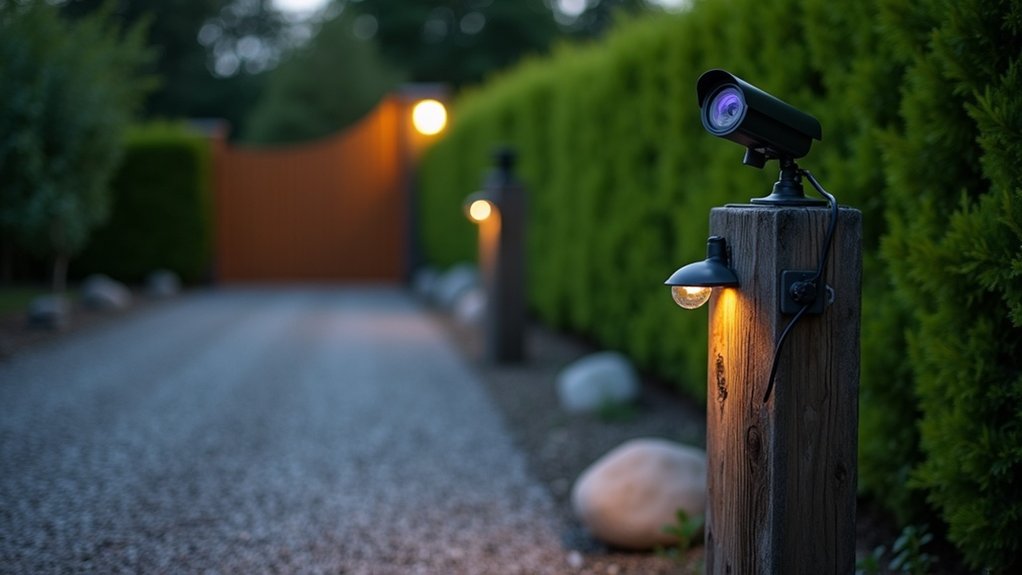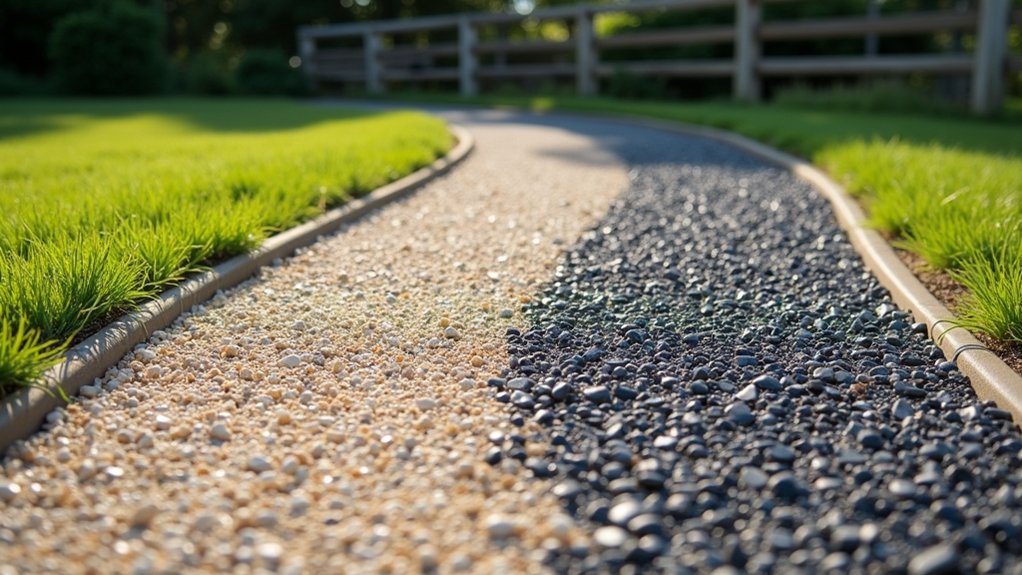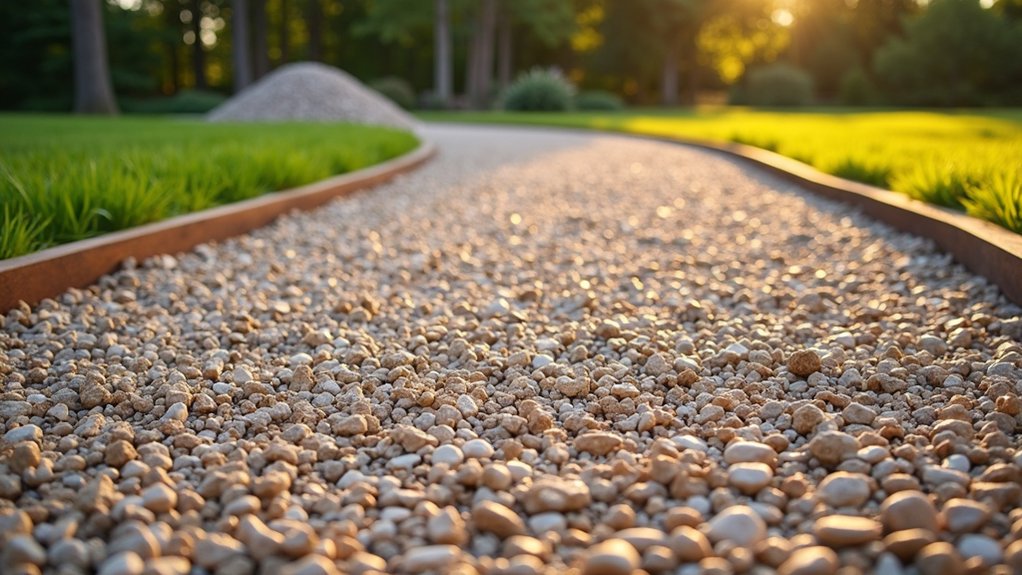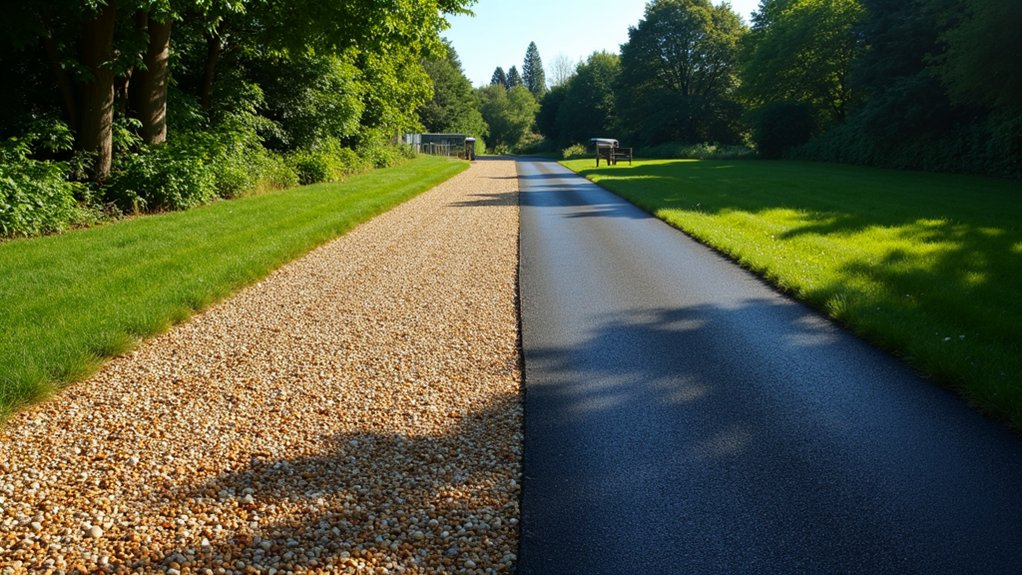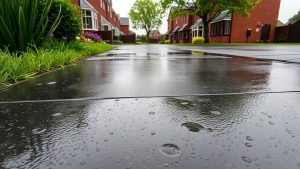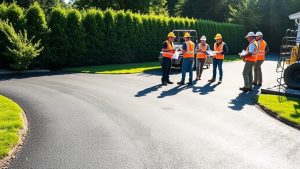To secure your gravel driveway against theft and trespassing, start by assessing potential entry points and sightlines. Using gravel can enhance security, as it makes noise when someone approaches, acting as a natural deterrent. Consider installing physical barriers such as automated gates and clear signage to discourage unwanted visitors.
To maintain the integrity of your gravel and prevent erosion, use ground stabilisation techniques. Regular inspections and maintenance are essential for ongoing security. Additionally, integrating smart technology, like cameras or motion sensors, can further bolster your security measures and provide peace of mind.
Table of Contents
ToggleKey Takeaways
- Install sturdy gates and automate them for secure access, making it harder for unauthorised individuals to enter.
- Add motion sensor lighting to brighten the driveway when movement is detected, discouraging potential intruders.
- Use gravel with sensors to create an alert system that sounds when someone approaches.
- Keep the driveway well-maintained by regularly raking the gravel and clearing away debris to improve visibility and minimise hiding places.
- Set up surveillance cameras to keep an eye on activities and effectively deter trespassers.
Assessing Your Gravel Driveway Security Needs
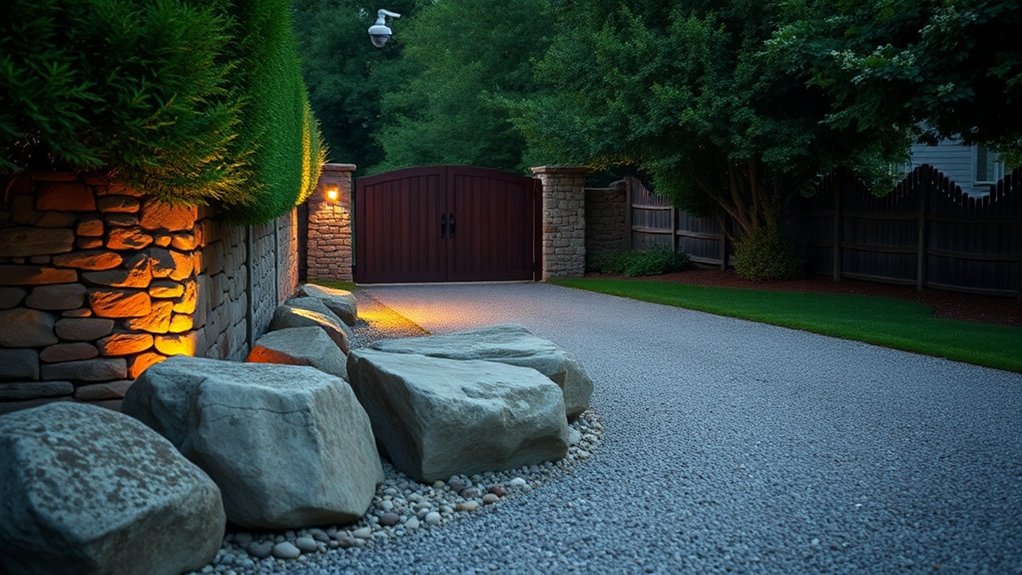
How can you assess the security needs of your gravel driveway? Start by examining the layout and identifying all entry points for vehicles and pedestrians. This will help you spot potential weak spots.
Check how close these access points are to public roads or alleys, as this could allow for unauthorized entry. Look at the sightlines from your house and nearby properties to ensure you can keep an eye on any activity.
Be wary of hidden paths that intruders might use. Consider traffic patterns, noting busy times and any foot traffic that could influence your security measures. Additionally, ensure that your driveway is made of stable gravel, as this can enhance both the security and overall durability of the area.
Finally, think about the area around the driveway and whether physical barriers or screening could boost security.
Enhancing Intrusion Detection With Gravel
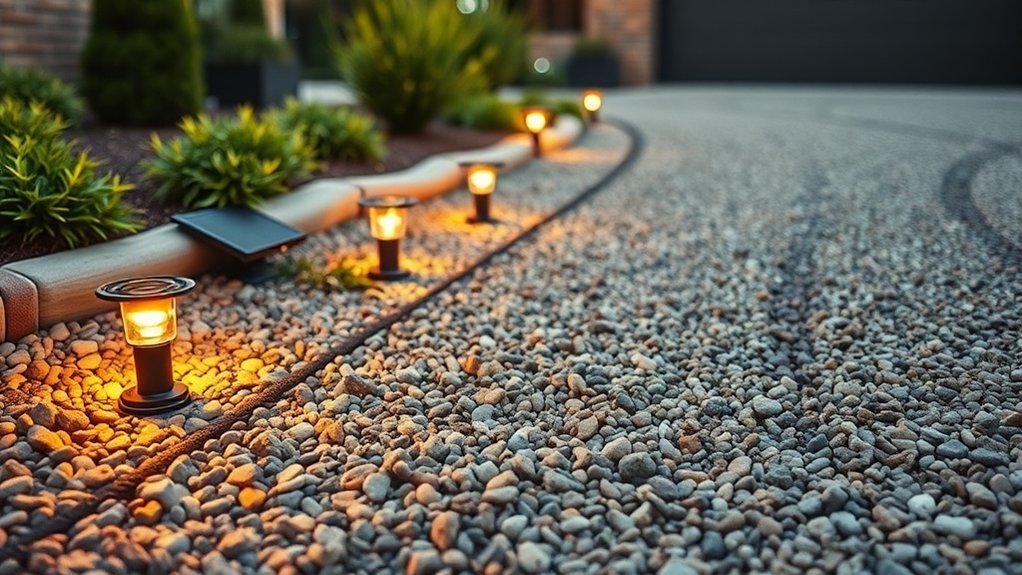
Enhancing Intrusion Detection with Gravel
Gravel driveways not only look appealing but also offer unique benefits for improving security. Here are some key advantages of using gravel for intrusion detection:
- Audible Alerts: The sound of gravel crunching underfoot acts as a natural alarm, making you aware of potential intruders.
- Deterrent Effect: The rough texture of gravel discourages quiet approaches, making it difficult for intruders to go unnoticed.
- Layered Security: Pairing gravel with sensors such as magnetic probes or passive infrared (PIR) detectors boosts detection effectiveness. This combination enhances detection range and ensures that movement is reliably monitored.
- Flexible Configuration: Gravel allows for easy sensor placement, ensuring optimal coverage while minimizing false alarms.
Implementing Physical Barriers and Controlled Access
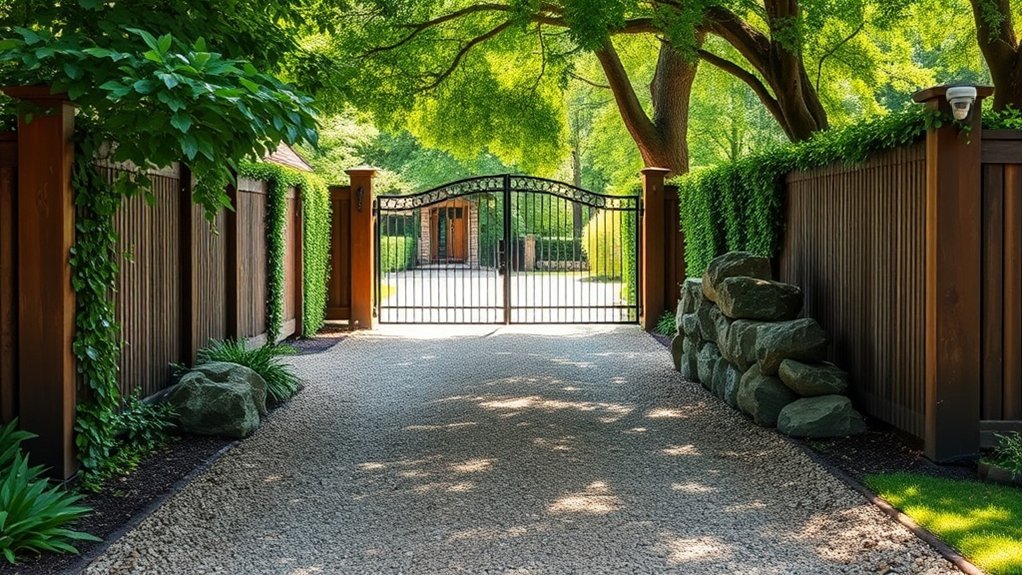
Implementing physical barriers and controlled access is crucial for securing your gravel driveway. Start by installing robust gates made of wrought iron or steel to deter unauthorised access. Consider automating the gates for ease of use, allowing quick entry for authorised users while maintaining security. Add clear signage and visible house numbers to assist emergency services and help prevent unauthorised incidents. Motion sensor lighting can also be beneficial, illuminating the area during potential intrusions and discouraging trespassers. Installing strong security bollards or concrete barriers creates a significant physical presence. It’s important to choose barriers that not only serve their purpose but also complement the aesthetic of your property. Regular maintenance will ensure their effectiveness and longevity, as well as increased security measures that deter potential threats.
Utilizing Ground Stabilization and Gravel Retention Techniques
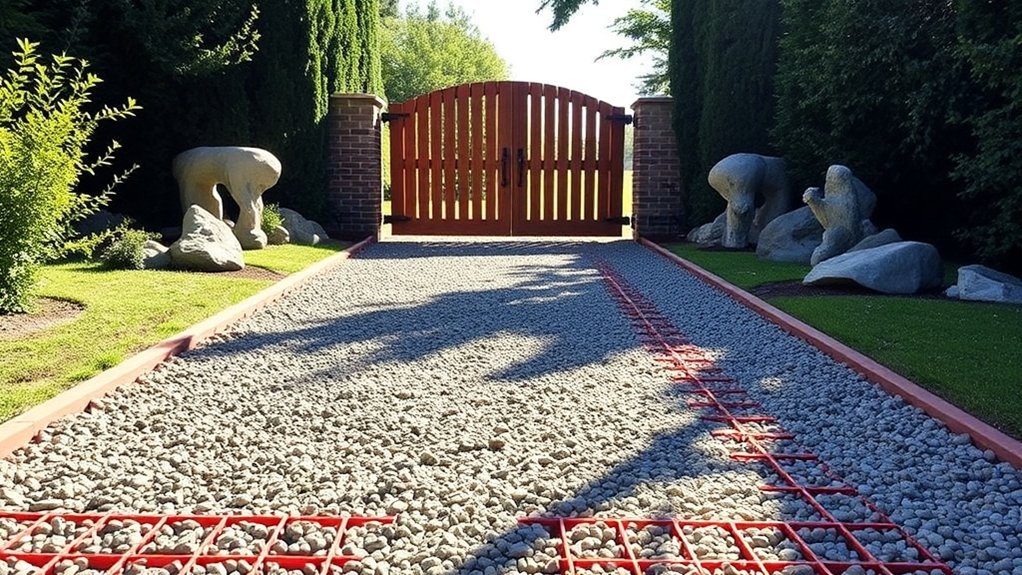
To secure your gravel driveway effectively, consider using erosion control solutions along with robust ground protection mats.
These approaches help prevent soil displacement and ensure your driveway remains intact during different weather conditions.
For instance, using geotextile mats beneath your gravel can enhance stability and reduce maintenance needs.
Erosion Control Solutions
Erosion control solutions are vital for preserving the integrity of gravel driveways, particularly on sloped surfaces where runoff can lead to significant displacement.
Here are some effective strategies to consider:
- Install GeoGrid systems to stabilise gravel and manage water flow.
- Opt for high-quality “crusher run” gravel that compacts well and resists erosion.
- Create crowned slopes to direct water away from the main path, minimising washout.
- Use permeable pavers for improved stability and reduced displacement during heavy rain.
Durable Ground Protection Mats
While gravel driveways may seem straightforward, using durable ground protection mats can significantly improve their stability and longevity.
These mats, made from hardwood, composite materials, or recycled plastics, are highly durable and can support heavy loads—some up to 100 tonnes. By distributing weight evenly, they help prevent rutting and gravel displacement, keeping the surface stable.
Many designs feature interlocking connectors, which enhance stability and limit gravel spread, reducing the risk of unwanted access. They’re easy to install, reusable, and require little maintenance, making them suitable for various weather conditions.
Regular inspection and cleaning can extend their lifespan, providing an effective solution for protecting your gravel driveway against theft and unauthorised use.
Establishing Regular Maintenance and Safety Practices
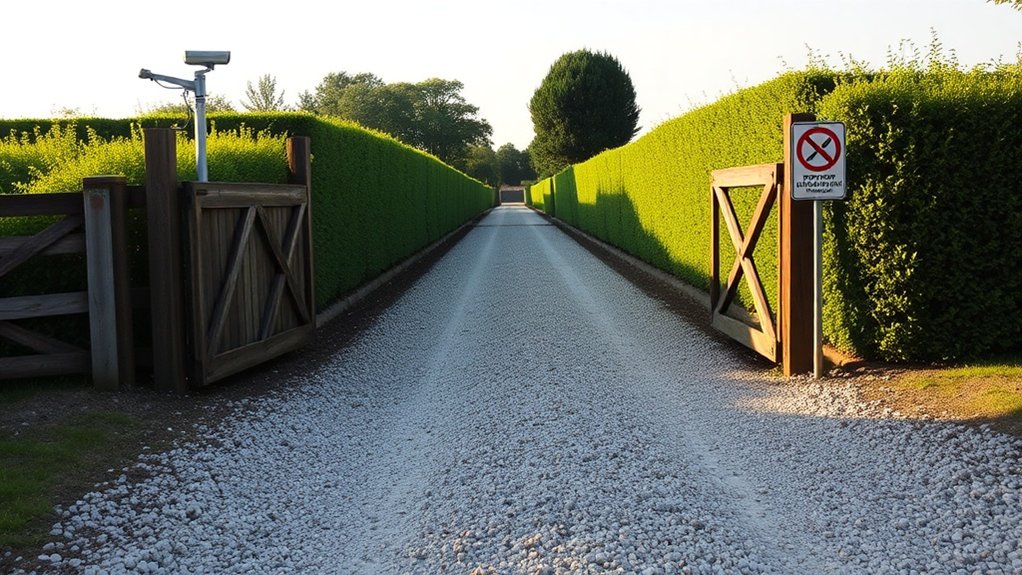
Establishing regular maintenance and safety practices for your gravel driveway is vital for extending its lifespan and ensuring safe access.
Consistent gravel upkeep can help you avoid expensive repairs and improve security. Here are four essential practices to consider:
- Inspect regularly to identify damage early, potentially reducing repair costs by up to 50%.
- Rake the gravel often to clear debris and maintain an even surface, which enhances traction.
- Remove debris and vegetation to keep visibility clear and discourage unauthorised access.
- Prepare for seasonal changes by redistributing gravel and checking for erosion, ensuring a smooth surface throughout the year.
Considering Environmental and Landscape Factors
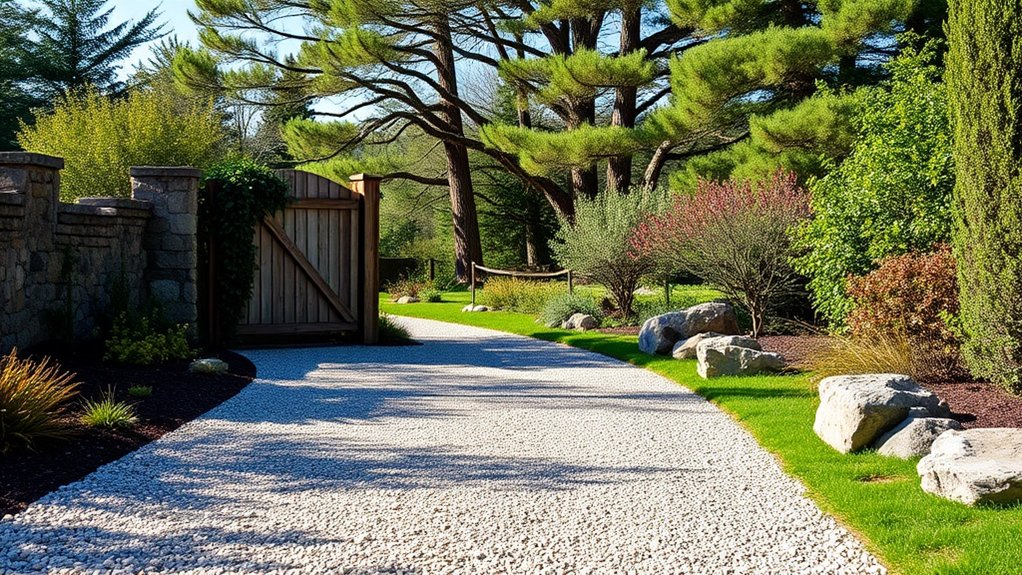
To secure your gravel driveway effectively, trim back overgrown vegetation, keep an eye on drainage issues, and clearly define parking spaces.
Trimming plants improves visibility and reduces potential hiding spots for intruders.
Addressing drainage problems helps maintain your driveway’s surface, while clearly marked parking areas enhance both security and organisation.
Trim Vegetation Strategically
Trimming vegetation strategically along your gravel driveway not only improves visibility but also enhances security and supports environmental health.
Here are some key points to consider:
- Keep vegetation low to improve sightlines, which can deter potential trespassers.
- Clear away dense shrubs and overhanging branches to allow more sunlight, reducing areas for weeds and insects to thrive.
- Create a buffer zone of trimmed plants to limit hiding spots for intruders.
- Opt for native, drought-tolerant species to benefit local ecosystems and decrease water usage.
Monitor Drainage Issues
Keeping your gravel driveway secure involves more than just trimming back overgrown vegetation; monitoring drainage issues is crucial too.
Start by ensuring proper drainage. Consider installing culverts or perforated pipes under your driveway to prevent erosion and water pooling. Design ditches on the uphill side to catch runoff before it reaches the surface. Planting vegetation in these ditches can help stabilise the soil and slow down water flow.
Regularly check subsurface drains for blockages, and make sure your gravel base is well-compacted to improve drainage.
It’s also wise to assess your soil type and landscape to tailor your drainage system to seasonal rainfall patterns. By tackling these drainage concerns proactively, you’ll enhance the stability and safety of your driveway.
Define Parking Spaces
To define parking spaces effectively, it’s essential to consider environmental and landscape factors for a sustainable gravel layout. Here are the key points:
- Space Dimensions: Standard parking bays should measure approximately 2.4 metres wide by 4.8 metres long, taking into account the characteristics of gravel.
- Soil Stability: The type of soil matters; clay soils need different preparation compared to sandy ones.
- Drainage: Steer clear of areas prone to water accumulation to prevent erosion and gravel movement.
- Environmental Sensitivity: Locate parking spaces away from wetlands or protected areas to minimise ecological disruption.
Integrating Technological Enhancements for Security
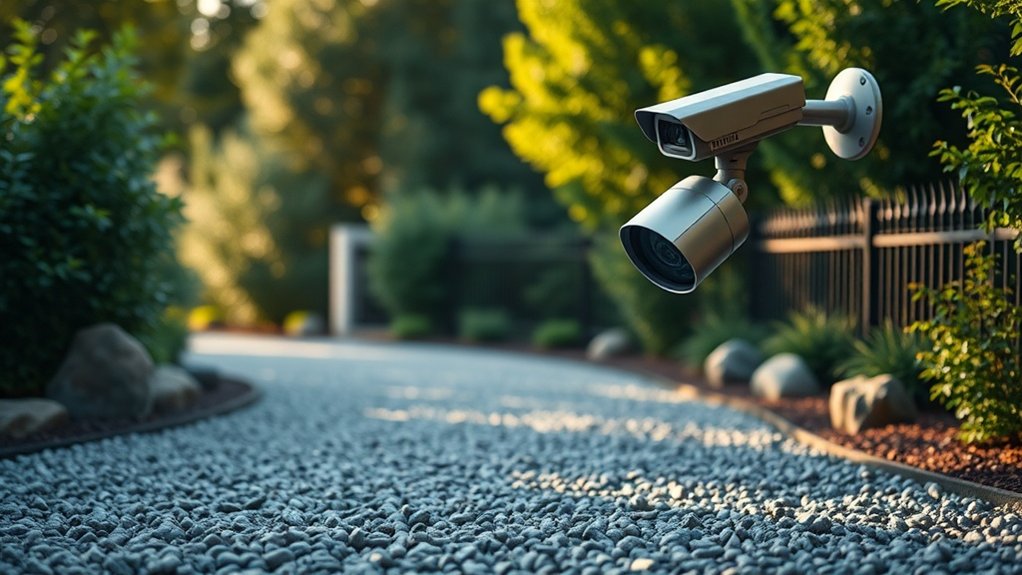
Integrating technological enhancements for security in your gravel driveway can significantly improve protection against unauthorised access and potential threats. By using sensor technology, you can install underground probes that detect vehicles within 3-4 metres, helping to minimise false alarms. Pairing these with smart lighting and video surveillance boosts visibility and monitoring.
| Feature | Benefits |
|---|---|
| Sensor Technology | Detects vehicles, reduces false alarms |
| Remote Monitoring | Real-time alerts to your smartphone |
| Smart Lighting | Deters intruders, conserves energy |
These enhancements not only make your property safer but also provide peace of mind.
Creating a Comprehensive Security System for Your Driveway
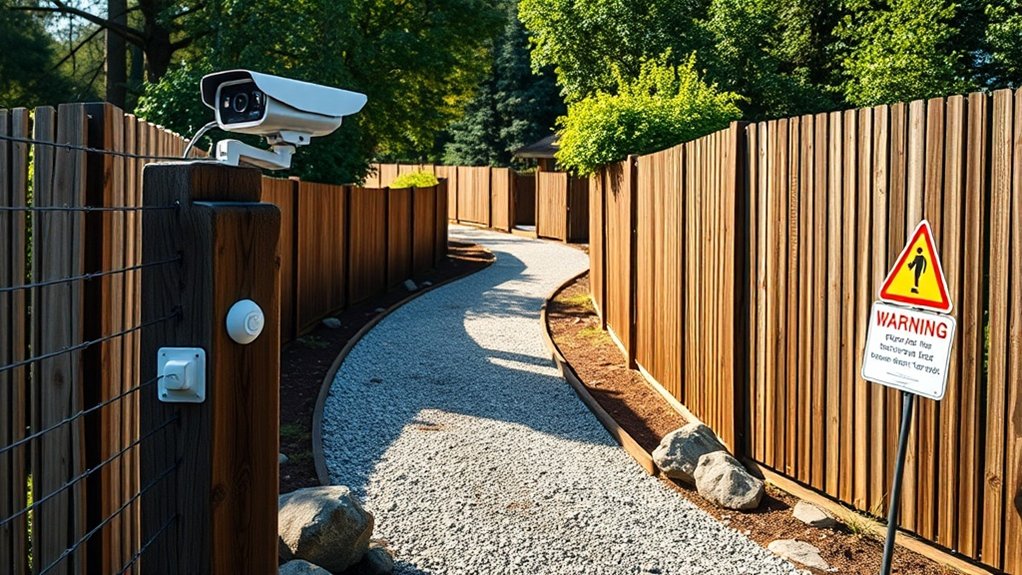
Securing your driveway may seem simple, but developing a comprehensive security system requires careful thought.
To boost your driveway’s safety, consider the following:
- Physical Barriers: Install decorative bollards or large planters to prevent unauthorised vehicle access.
- Surveillance Technology: Set up security cameras to monitor activity and deter intruders.
- Noise-Based Alerts: Lay a strip of loose gravel to create noise when someone approaches.
- Landscaping: Trim bushes and trees to remove hiding spots, enhancing visibility.
Frequently Asked Questions
What Types of Gravel Are Best for Security Purposes?
For security purposes, crushed stone and dense grade gravel are ideal choices. These types of gravel lock together, providing stability and reducing movement, which enhances security. Their compact and resilient nature makes it difficult for unauthorised access, effectively deterring intruders.
How Do I Choose the Right Gravel Depth for My Driveway?
To select the appropriate gravel depth for your driveway, take into account the traffic load and soil conditions. For everyday use, aim for a depth of 10 to 15 centimetres (4 to 6 inches). This will provide stability and promote effective drainage, helping to prevent issues like sinking or ruts. For example, if you have heavier vehicles regularly using the driveway, it may be wise to opt for the deeper end of that range.
Can Gravel Driveways Support Heavy Vehicles Without Damage?
To assess whether a gravel driveway can support heavy vehicles, it’s essential to consider its strength. If the gravel is properly layered and compacted, it can withstand significant loads without suffering damage. For instance, a well-constructed gravel driveway can accommodate vehicles like delivery vans or even larger lorries, ensuring durability and reducing the need for frequent maintenance.
What Are the Best Plants to Use Near Gravel Driveways for Security?
To boost security around your gravel driveway, consider planting thorny shrubs such as pyracantha and holly. These create thick hedges that act as effective barriers, deterring intruders while enhancing the visual appeal of your garden.
How Can I Enhance the Aesthetics of a Gravel Driveway While Securing It?
To enhance the aesthetics of your gravel driveway, think about adding decorative borders using contrasting gravel colours. You could also install landscape lighting along the edges to illuminate the path at night, which not only beautifies the area but also helps deter unwanted visitors.
Conclusion
Securing your gravel driveway goes beyond just putting up barriers; it’s about creating a protective environment that deters potential threats. Start by assessing your specific needs and combining physical measures—like gates and fencing—with technological solutions, such as security cameras and motion-sensor lights. Regular upkeep of your driveway not only keeps it looking good but also ensures it remains secure. Consider planting thorny bushes or installing gravel borders to add an extra layer of defence. With these strategies, you can turn your driveway into a reliable safeguard for your home, ensuring peace of mind around the clock.
Keen to enhance your driveway with the right gravel? Discover the best types and find out which one suits your Read more
How to enhance your gravel driveway's stability and durability? Discover key strategies that can transform your drive into a long-lasting Read more
Uncover the essential differences between gravel driveways and tarmac, and find out which option truly suits your needs best.

